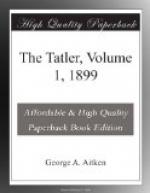Preface
The original numbers of the Tatler_ were reissued in two forms in 1710-11; one edition, in octavo, being published by subscription, while the other, in duodecimo, was for the general public. The present edition has been printed from a copy of the latter issue, which, as recorded on the title-page, was “revised and corrected by the Author”; but I have had by my side, for constant reference, a complete set of the folio sheets, containing the “Lucubrations of Isaac Bickerstaff” in the form in which they were first presented to the world. Scrupulous accuracy in the text has been aimed at, but the eccentricities of spelling—which were the printer’s, not the author’s—have not been preserved, and the punctuation has occasionally been corrected.
The first and the most valuable of the annotated editions of the Tatler was published by John Nichols and others in 1786, with notes by Dr. Percy, Bishop of Dromore, Dr. John Calder, and Dr. Pearce, Bishop of Rochester; and though these notes are often irrelevant and out of date, they contain an immense amount of information, and have been freely made use of by subsequent editors. I have endeavoured to preserve what is of value in the older editions, and to supplement it, as concisely as possible, by such further information as appeared desirable. The eighteenth-century diaries and letters published of late years have in many cases enabled me to throw light on passages which have hitherto been obscure, and sometimes useful illustrations have been found in the contemporary newspapers and periodicals.
The portraits of Steele, Addison, and Swift, the writers most associated with the Tatler, have been taken from contemporary engravings in the British Museum; and the imaginary portrait of Isaac Bickerstaff in the last volume is from a rare picture drawn by Lens in 1710 as a frontispiece to collections of the original folio numbers._
G. A. A.
August 1898.
INTRODUCTION
When the first number of the Tatler appeared in 1709, Steele and Addison were about thirty-seven years of age, while Swift, then still counted among the Whigs, was more than four years their senior. Addison and Steele had been friends at the Charterhouse School and at Oxford, and though they had during the following years had varying experiences, their friendship had in no way lessened. Addison had been a fellow of his college, had gained the patronage of Charles Montague and Lord Somers, had made the grand tour, and published an account of his travels; had gained popularity by his poem “The Campaign,” written in celebration of the victory at Blenheim; had been made an Under-Secretary of State, and finally (in December 1708) had been appointed secretary to Lord Wharton, the Lord Lieutenant of Ireland. Steele, on the other hand, had enlisted in the Guards,




